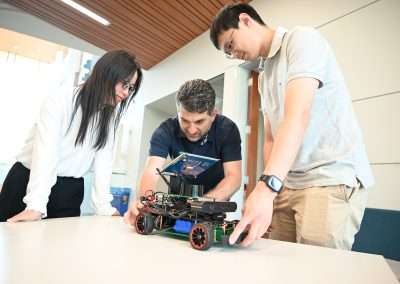By Bob Grant
In 2023, Shaowen Wang, Ph.D., was awarded a block grant from the Taylor Geospatial Institute to use geospatial technologies and artificial intelligence to reimagine the ways that water features, such as rivers and streams, are mapped as they wind across Earth’s surface. His TGI-funded project is titled, “An Integrated CyberGIS and Deep Learning Framework for Scalable Hydrographic Mapping.”
University of Illinois Urbana-Champaign geographer and computer scientist Shaowen Wang, Ph.D., has a long list of academic duties.
Dr. Wang is a professor in the Department of Geography and Geographic Information Science, an affiliate professor in the Siebel School of Computing and Data Science, Department of Urban and Regional Planning, and School of Information Sciences, and he currently serves as Associate Dean for Life and Physical Sciences of the College of Liberal Arts and Sciences. He is also a Senior Faculty Fellow with the Office of the Vice Chancellor for Research and Innovation at Illinois. As if that weren’t enough, Dr. Wang has also served as Founding Director of the CyberGIS Center for Advanced Digital and Spatial Studies at UIUC since 2013.
But what really drives Dr. Wang, is research. A self-described geographic information scientist, and a member of the Taylor Geospatial Institute’s Research Council, in 2023 Dr. Wang and collaborators received a TGI block grant to study how artificial intelligence could be used to improve the mapping of water features on Earth. That funding helped Dr. Wang and a spate of coauthors publish a paper entitled, “Transfer learning with convolutional neural networks for hydrological streamline delineation,” that will be published in the October print issue of Environmental Modelling & Software.
The paper, Dr. Wang explained, represents initial confirmation that using artificial intelligence methods, such as deep learning, can be used to construct models of complex, dynamic Earth features like the course of waterways and furthermore can be transferred to other rivers and streams to predict their courses with relative accuracy. “Environmental features like waterways, water bodies—and possibly the heterogeneity associated with these environmental features like topography—these are so different, so nuanced across different geographical areas,” he said. “So that’s the primary focus of this study, and I think the breakthrough here is it could work.”
Dr. Wang and his collaborators constructed a model of a small watershed in Rowan County, North Carolina (the so-called source domain), and used transfer learning—which is a type of the AI method of deep learning—to predict the features of a Covington River watershed in Virginia (the target domain). “We intentionally chose two very different geographical areas,” he noted. “You take what you learn from an area with the streamlines, and then you move this to a new area that is very different. And then for the target domain, you fine tune and have this process accounting for the variations of the features, and at the same time, take advantage of the knowledge coming from the source domain, and then we demonstrated we will be able to achieve decent performance for detecting the features of the streamlines in the target domain.”
Now that his team has demonstrated that this AI approach can work for such predictive, transferrable hydrologic mapping, Dr. Wang said that the next step is to make the approach scalable, eventually on a global basis.
This scalability is simply not realistic using conventional methods of hydrologic mapping, which include aerial surveys and calculations of the physics affecting water flow. “It really opens the door for this methodology to be applicable to very large-scale learning exercise and the predictive tasks, compared to the conventional methodology that is mechanistically delineating water features,” he noted. “So we see the potential of moving beyond the conventional methodology to the AI deep learning space, because this work really demonstrates the scalability, feasibility, as well as potential in learning from an existing area applied to a new area without having to learn from scratch.”
Information about Dr. Wang’s research can be found at taylorgeospatial.org/associates, a database of all of TGI Associates showing the unique work they are doing in geospatial.
To stay up to date with TGI activities, subscribe to our newsletter.




